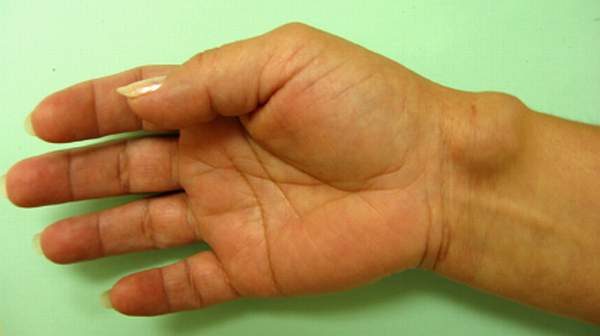What's in this article?
A ganglion cyst is a tumor or swelling on top of a joint or the covering of a tendon (tissue that connects muscle to bone). It looks like a sac of liquid (cyst). Inside the cyst is a thick, sticky, clear, colorless, jellylike material. Depending on the size, cysts may feel firm or spongy.
Ganglion Cyst Causes
The cause of ganglion cysts is not known. One theory suggests that trauma causes the tissue of the joint to break down, forming small cysts that then join into a larger, more obvious mass. The most likely theory involves a flaw in the joint capsule or tendon sheath that allows the joint tissue to bulge out.
Ganglion Cyst Symptoms
- The ganglion cyst usually appears as a bump (mass) that changes size.
- It is usually soft, anywhere from 1-3 cm in diameter, and doesn’t move.
- The swelling may appear over time or appear suddenly, may get smaller in size, and may even go away, only to come back at another time.
- Most ganglion cysts cause some degree of pain, usually following acute or repetitive trauma, but up to 35% are without symptoms except for appearance.
- If pain is present, it is usually chronic and made worse by joint motion.
- When the cyst is connected to a tendon, you may feel a sense of weakness in the affected finger.
Risk factors of Ganglion Cyst
Factors that may increase your risk of ganglion cysts include:
- Your sex and age. Although ganglion cysts can develop in anyone, they most commonly occur in women between the ages of 20 and 30.
- Osteoarthritis. People who have wear-and-tear arthritis in the finger joints closest to their fingernails are at higher risk of developing ganglion cysts near those joints.
- Joint or tendon injury. Joints or tendons that have been injured in the past are more likely to develop ganglion cysts in the future.
Treatment for Ganglion Cyst
Nonsurgical Treatment
Initial treatment of a ganglion cyst is not surgical.
- Observation. Because the ganglion is not cancerous and may disappear in time, if you do not have symptoms, your doctor may recommend just waiting and watching to make sure that no unusual changes occur.
- Immobilization. Activity often causes the ganglion to increase in size and also increases pressure on nerves, causing pain. A wrist brace or splint may relieve symptoms and cause the ganglion to decrease in size. As pain decreases, your doctor may prescribe exercises to strengthen the wrist and improve range of motion.
- Aspiration. If the ganglion causes a great deal of pain or severely limits activities, the fluid may be drained from it.
This procedure is called an aspiration.
The area around the ganglion cyst is numbed and the cyst is punctured with a needle so that the fluid can be withdrawn.
Aspiration frequently fails to eliminate the ganglion because the “root” or connection to the joint or tendon sheath is not removed. A ganglion can be like a weed which will grow back if the root is not removed. In many cases, the ganglion cyst returns after an aspiration procedure.
Aspiration procedures are most frequently recommended for ganglions located on the top of the wrist.
Surgical Treatment
Your doctor may recommend surgery if your symptoms are not relieved by nonsurgical methods, or if the ganglion returns after aspiration. The procedure to remove a ganglion cyst is called an excision.
Surgery involves removing the cyst as well as part of the involved joint capsule or tendon sheath, which is considered the root of the ganglion. Even after excision, there is a small chance the ganglion will return.





